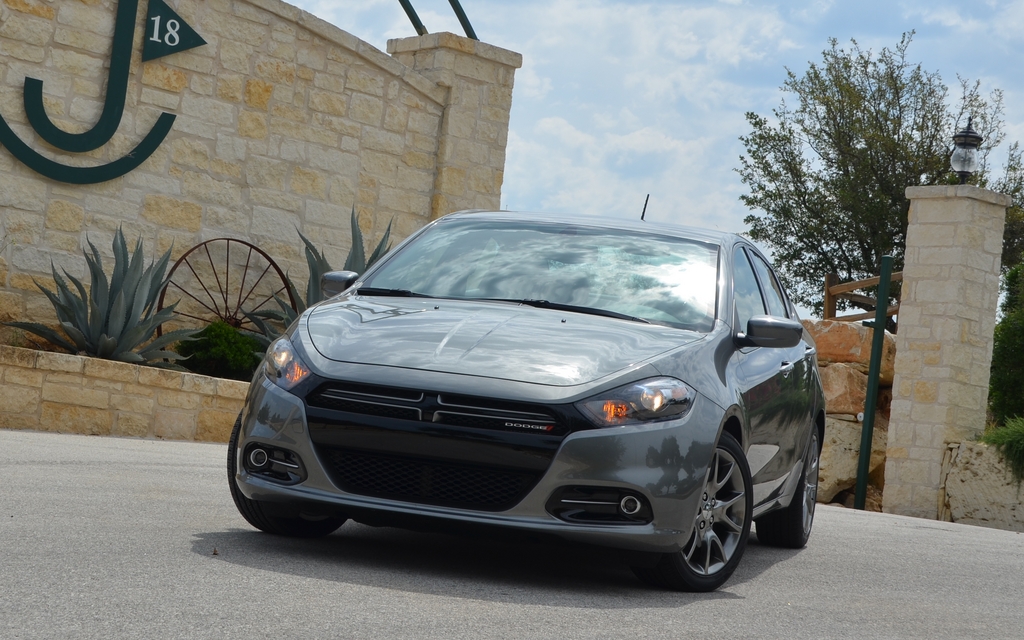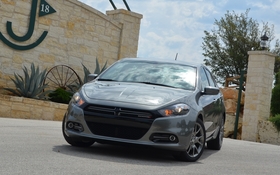2013 Dodge Dart: The future with a pinch of the past

| Strong points |
|
|---|---|
| Weak points |
|
Anyone with even a passing interest in cars has heard of the Dart, sold between 1960 and 1976 in various incarnations. The 2013 Dart is Chrysler’s first child from its current marriage (the previous marriage, with Daimler, ended in divorce) to Fiat. This new vehicle replaces the controversial Caliber, which many people have already forgotten.
There’s a certain irony in the idea that the future is now riding on a car that marked the history of the brand but that has been dead and buried for 36 years. That being said, the new Dart is very modern, although it’s based on the Alfa Romeo Giulietta and the Lancia Delta, which, in turn, were derived from the Fiat Bravo. So, you can’t really say that the Dart is completely new.
This latest Dart is rather nice-looking – even nicer in person than in photos. In the passenger compartment, the dashboard is particularly well executed and now features good quality materials.
From $15,995 to $23,995 and up!
There are five trim levels of the Dart: SE, SXT, Rallye, Limited and R/T. Of course, the equipment level increases as you climb the hierarchy and while its base version goes for $15,995, you can also have a Dart for $23,995. This more expensive version, the R/T, will not be deliverable until fall 2012. The SE comes factory standard with remote keyless entry, four-wheel disc brakes, power windows and mirrors and ten airbags. The SXT adds, among other things, 17-inch wheels. The Rallye has a distinctive front protective shield and a leather-covered steering wheel. The Limited version offers the Uconnect Touch system with its 8.4-inch screen and the instrument cluster is configurable using a 7-inch screen factory standard. As for the R/T, it features the 2.4-litre four-cylinder and 18-inch aluminum wheels. Obviously, the options list is always there to help you customize your Dart according to your tastes and means.
Yawns and wows
Three engines and three transmissions will fight it out for control of this car. The base engine is a 2.0-litre four-cylinder 160-hp Tigershark (don’t you just love engine names that suggest power – like the Magnum, Marauder and Super Rocket from back in the day). This engine comes standard with the SE, SXT, Rallye and Limited. There’s also a 1.4-litre four-cylinder MultiAir that’s already used in the Fiat 500 and is available on option on the previously mentioned trims. Finally, the R/T’s 2.4-litre four-cylinder Tigershark MultiAir promises no shortage of excitement with its 184 horses and 181 lbs-ft of torque.
All of these engines (except the Limited’s 2.0-litre) are paired factory standard with a six-speed manual gearbox. A six-speed automatic is offered on option with the 2.0- and 2.4-litre engines. It will be possible, within the next few months, to pair the 1.4-litre with a six-speed automatic dual dry clutch transmission (DDCT).
At the launch, we drove two cars, each equipped with the 2.0-litre engine. One was equipped with the automatic transmission and the other with the manual. The latter’s clutch, which was not sufficiently progressive or punchy, was disappointing. We were also let down by the barely adequate stick shift handling and the gear ratio. When you’re out for a drive on a curvy or hilly road, you’ll constantly have to play with the stick to try to get the best out of the engine, which begins at about 4,000 rpm. The automatic transmission is much smoother and a hastily done 0-100 km/hr gave us a time of 12 seconds – and the road dipped slightly downhill! More tests will have to be performed.
Evidently, this 2.0-litre, despite its 160 horses at 6,400 rpm and 148 lbs-ft of torque at 4,600 rpm, lacks power and its sole purpose is to keep the car’s starting price down. If you’re more interested in good equipment than in an exciting ride, you should be satisfied with this compromise.
The 1.4-litre engine doesn’t develop a single horse more than the 2.0-litre, but it does it at less rpm (5,500), which is a clear advantage. Furthermore, its torque is reasonably higher with 184-lbs-ft between 2,500 and 4,000 rpm. These figures make it a lot more responsive and while the manual transmission has the same gear ratio, it is much more at ease with the 1.4. Although the accelerations are livelier, there’s no torque effect in the front wheels, since the Dart is, of course, a front-wheel drive.
The bosses at Dodge claim that the cars equipped with the 1.4- and 2.0-litre engines have identical suspension settings and steering. But our test drive led us to conclude that the 1.4-litre version’s suspension is slightly more rigid (but not uncomfortable) and its steering is more responsive. And before you ask, yes, both used the same ContiproContact 225/45R17 tires. For a sportier suspension, you’ll have to opt for the R/T.
Calm and jazzy
In terms of handling, this car reminded me a lot of the Ford Focus. Obviously, it’s not nearly as dynamic as the Mazda3.
The Dart has comfortable seats and numerous storage compartments, though the glove compartment is about big enough for a cell phone (not that we actually tried to put one in it). The trunk is a nice size and the back seats are very decent back. Basically, this is a serious car.
With twelve body colours and fourteen possible colour and layout combinations (depending on the trim), the Dart is bringing more than a name back from the past. In passenger compartments that generally feature grey, beige and black, it’s also bringing some colour back. And the options catalogue and Mopar accessories will undoubtedly also add more colour in the Dart’s life.











